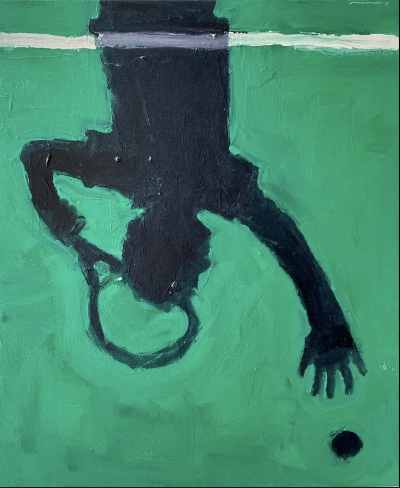Tennis Artists
Led by Honor Titus, four young artists are redefining tennis through art

Almost since tennis was instituted into lawn parties across England, America and their colonies, artists have been around to capture the particulars and peculiarities of the sport. Restrained, precise, decidedly unemotional, Eric Ravilious (1903–1942) was chosen to help represent the English way of life at the 1937 International Exhibition in Paris. Normally prone to depicting unpeopled landscapes, he started painting scenes dominated by tennis games, such as his Tennis Triptych now in the Bristol Museums. Cyril Power, another English illustrator, brought his architectural lens to all sorts of sports, but his Tennis linotype breaks down the beauty of tennis motion into brilliant swooping contours. In America, Leroy Neiman and New York’s Hammer Graphics paired up to give Jimmy Connors and Rod Laver the “pop art” treatment, bringing in cash hand over fist for his ubiquitous prints during the late 70s and early 80s.
Tennis may carry a feeling of a one-dimensional, staid sport to the general public, but tennis players themselves have finished their first careers and taken on second ones as fashion designers (Ted Tinling), musicians and collectors (John McEnroe), interior decorators (Venus and Serena Williams) and amateur art historians (Reilly Opelka). Six years after the creation of Courts magazine, the Maison des Arts d’Uccle is hosting Tennis is Art, a retrospective of the art and the artists that have graced the cover of this magazine, including, Minimiam, micro photographers of playful tennis sketches in 1/87 scale, Mathilde Wittock, who reinforces benches and other public fixtures with used balls and other gear, and Jean-Philippe Bertrand , a sculptor who can reimagine a broken wooden racquet into anything from a rooster to a guitar. Showing until 14 April, Courts has managed to wrangle only a fraction of the artists currently using tennis as inspiration. While the following have also made a brief appearance at galleries across the world, they could end up at the Maison des Arts d’Uccle next year.

Honor Titus
Honor Titus never actually aimed at a career in art. The son of Andres “Dres” Vargas Titus of the seminal rap group Black Sheep, the Brooklyn-born Titus had his sights set on punk rock infamy. His band, Cerebral Ballzy, actually made it, landing a record deal at Strokes lead-singer Julian Casablaca’s label, Cult Records and dates at UK Festivals, including Reading and Leeds. But when he started an album-cover collaboration with anti-authoritarian artist Raymond Pettibon, Titus became the Basquiat to Pettibon’s Warhol. He began working in Pettibon’s studio, where he assisted in the artist’s stylized ink drawings developed an interest in painting. After Titus relocated across t he country to Los Angeles in 2016, he developed a vibrant, painterly style while synthesizing ritual formality of tennis with hyper-realist brands. A tennis enthusiast since his LA move, within four years Titus was discovered by uber-gallerist Larry Gagosian; his show “Advantage In,” which ran from 20 July to 1 September, was hailed as looking “back to Hopper and forward to Kerry James Marshall.”


Rinus Van De Velde
Spanning various media, the Belgian artist, Rinus Van de Velde creates large-scale, fictional self-portraits and life-size decors for his installations and videos that explore the relationship between his reality and fiction. Convinced that art is not born of one sole truth, Van de Velde often depicts himself as the protagonist of his work, as well as the victim, such as in the 2022 oil pastel “Dear, a studio visit is a bit difficult at the moment …” in which Van de Velde is pictured in a basement laundry surrounded by piles of notebooks, papers, cloths and all other accoutrement. Van de Velde’s works are systematically accompanied by two or three sentences at the bottom that promise a bigger story. On the representation of an colorful, yet empty, tennis court there is this for explanation: “Now I have to find my big serve.” Van de Velde’s latest gambit, A Life in a Day — with former professional and current art gallery owner, Tim Van Laere — this time shows the reality of his life, mixing the magic of his daydreaming with his actual routine. Van de Velde gets up and he smokes and he paints and he smokes and he only leaves his studio to meet Van Laere — the man who convinced Van de Velde to return to tennis after injuring his elbow painting — to play tennis. Sometimes daydreams do become reality.

Todd Bievenu
Louisiana State University-educated, Arkansas artist’s dense figurative paintings depict sex, tattooed rockers, beaches, alcohol, urban scenes, parties — and tennis.

Nicholas Lambelet Coleman
a Swiss-American painter whose work broadly encompasses portraiture, still-life and interiors builds his own universe — the product of his peculiar, intimate relationship with his medium — and that includes self-portraits of his younger self as a champion tennis player. This article would profile all four artists and examine their relationships with tennis. It would also ask and answer the question of how tennis culture inspires art and vice-versa, and profile the players who are also prominent collectors, including Reilly Opelka and Venus Williams. 2,000 words.
